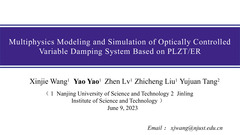Multiphysics Modeling and Simulation of Optically Controlled Variable Damping System Based on PLZT/ER
ID:72
Submission ID:13 View Protection:ATTENDEE
Updated Time:2023-03-14 09:52:22 Hits:821
Oral Presentation
Abstract
An optically controlled variable damping system based on intelligent photoelectric material PLZT / electrorheological fluid is proposed. In this paper, the structure of the optically controlled variable damping system is built, the mathematical model of PLZT photovoltage and the hydrodynamic model of electrorheological fluid are established, and the relationship between the pressure difference and the light intensity at both ends of the damping channel is deduced. Finally, the simulation analysis is carried out by COMSOL Multiphysics. The simulation results show that the pressure difference at both ends of the channel increases with the increase of light intensity. The farther the fluid is from the central axis, the slower the speed is. This phenomenon is consistent with the mathematical model. When the light intensity is 20 mW / cm2, the theoretical curve intersects with the simulation curve, and the error is 0. With the increase of light intensity, the pressure difference at both ends of the damping channel gradually tends to be saturated. When the light intensity reaches 200 mW / cm2, the error between theory and simulation is 13.8 %. Therefore, when the light intensity changes in the range of 0-200 mW / cm2, the error between theory and simulation is between 0-13.8 %, and the difference is not large, which further verifies the rationality of the mathematical model.
Keywords
Light controlled variable damping,Electrorheological fluid,PLZT
Submission Author
Zhicheng LIU
Nanjing University of Science And Technology
Xinjie WANG
Nanjing University of Science and Technology
Zhen LV
Nanjing University of Science And Technology


Comment submit